
An airbase, sometimes referred to as a military airbase, military airfield, military airport, air station, naval air station, air force station, or air force base, is an aerodrome or airport used as a military base by a military force for the operation of military aircraft.

Royal Air Force Marham, commonly abbreviated RAF Marham is a Royal Air Force station and military airbase near the village of Marham in the English county of Norfolk, East Anglia.

Royal Air Force Coltishall more commonly known as RAF Coltishall is a former Royal Air Force station located 10 miles north-north-east of Norwich, in the English county of Norfolk, East Anglia, which operated from 1939 to 2006.

A hardened aircraft shelter (HAS) or protective aircraft shelter (PAS) is a reinforced hangar to house and protect military aircraft from enemy attack. Cost considerations and building practicalities limit their use to fighter size aircraft.
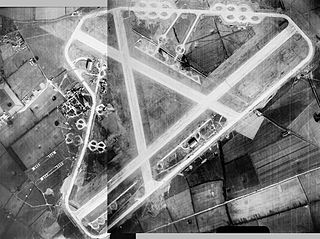
Sculthorpe Training Area, previously Royal Air Force Sculthorpe / , is a military training site administered by the Defence Training Estate, part of the Ministry of Defence (MoD). It is approximately 3 miles west of Fakenham in the county of Norfolk in England.

Royal Air Force Station Wildenrath, commonly known as RAF Wildenrath, was a Royal Air Force (RAF) military airbase near Wildenrath in North Rhine-Westphalia, Germany, that operated from 1952 to 1992. Wildenrath was the first of four 'clutch' stations built for the Royal Air Force in West Germany during the early 1950s.
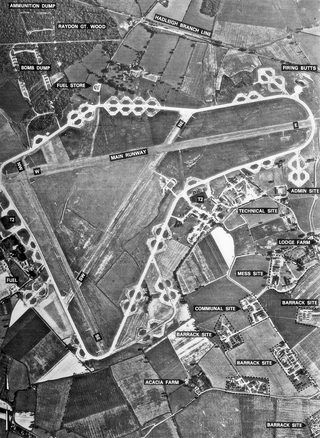
Royal Air Force Raydon or more simply RAF Raydon is a former Royal Air Force station located just to the northeast of the village of Raydon, about 6 miles (9.7 km) from Ipswich, England.
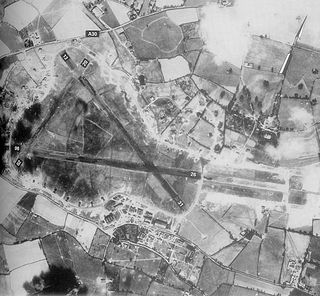
Class A airfields were World War II (WW2) military installations constructed to specifications laid down by the British Air Ministry Directorate General of Works (AMDGW). Intended for use by heavy bombers and transports, they were the standard airbase design for the Royal Air Force (RAF) as well as United States Army Air Forces (USAAF) units operating from the United Kingdom (UK).
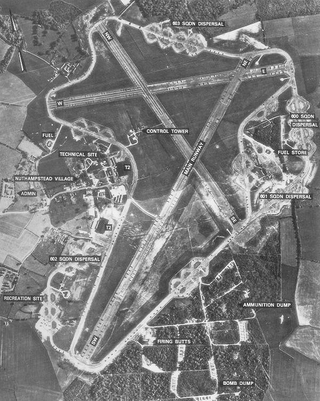
Royal Air Force Nuthampstead or more simply RAF Nuthampstead is a former Royal Air Force station in England. The airfield is located mostly in Hertfordshire between the villages of Nuthampstead and Anstey and the hamlet of Morrice Green in Hertfordshire and Langley, Lower Green and Clavering Park Wood in Essex. The eastern part of the airfield including part of the East-West Runway, the Fuel Store, the dispersal areas of 600 and 601 Squadrons and the northeastern perimeter track were all in Essex. RAF Nuthampstead is located four miles to the east of the A10 Hertford to Royston road.
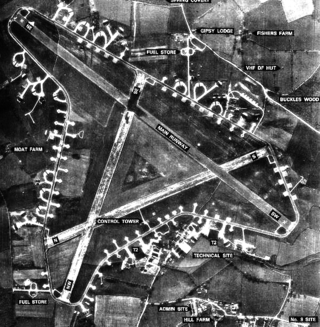
Royal Air Force Leiston or more simply RAF Leiston is a former Royal Air Force station located 1.5 km (0.93 mi) northwest of Leiston and 1 km (0.62 mi) south of Theberton, Suffolk, England.

Weapons Storage and Security System (WS3) is a system including electronic controls and vaults built into the floors of Protective Aircraft Shelters (PAS) on several NATO military airfields all over the world. These vaults are used for safe special weapons storage, typically of tactical B61 nuclear bombs. Historically the system was also called within NATO the Weapon Security and Survivability System (WS3) or Weapons Survivability and Security System.

Royal Air Force Halesworth or more simply RAF Halesworth is a former Royal Air Force station located 2 miles (3 km) north east of the town of Halesworth, Suffolk, England and 7 miles (11 km) west of Southwold.

Royal Air Force Rackheath, more commonly known as RAF Rackheath, is a former Royal Air Force station located near the village of Rackheath, approximately 6 miles north-east of Norwich, in the county of Norfolk in England.

Volkel Air Base is a military airbase used by the Royal Netherlands Air Force (RNLAF) - Dutch: Koninklijke Luchtmacht (KLu), located near the village of Volkel, Netherlands. Located in the north-east corner of the province of North Brabant, the air base is home to one F-16 Fighting Falcon squadron, No 312 and a F-35 squadron No 313 and a maintenance, logistical, base Squadron for the RNLAF.

Kleine Brogel Air Base is a Belgian Air Component military airfield located 0.8 nautical miles east of Kleine-Brogel, in the municipality of Peer, Belgium. It is home to the Belgian 10th Tactical Wing, which operates F-16 Fighting Falcons. As part of nuclear sharing it is also the home of the United States Air Force's 701st Munitions Support Squadron. As of 2023, Kleine Brogel is one of six active air bases in five European countries with B61 nuclear bombs in underground WS3 Weapon Storage and Security System inside aircraft shelters.
Juvincourt Airfield is an abandoned military airfield, which is located near the commune of Juvincourt-et-Damary in the Aisne department of northern France.

An underground hangar is a type of hangar for military aircraft, usually dug into the side of a mountain for protection. It is bigger and more protected than a hardened aircraft shelter (HAS).

H-3 Air Base is part of a cluster of former Iraqi Air Force bases in the Al-Anbar Governorate of Iraq. H3 is located in a remote stretch of Iraq's western desert, about 435 kilometers from Baghdad in western Iraq. It is close to the Syrian–Iraqi border, and near the highway that connects Jordan with Baghdad.

A revetment, in military aviation, is a parking area for one or more aircraft that is surrounded by blast walls on three sides. These walls are as much about protecting neighbouring aircraft as it is to protect the aircraft within the revetment; if a combat aircraft loaded with fuel and munitions was to ignite, a chain reaction might lead to the destruction of its neighbours. The blast walls around a revetment are designed to channel any blast and damage upwards and outwards, away from neighbouring aircraft.

Air force ground forces and special forces are the land warfare forces of an air force. They may include infantry, special forces, security forces, and military police. Airmen assigned to such units may be trained, armed and equipped for ground combat and special operations.



























